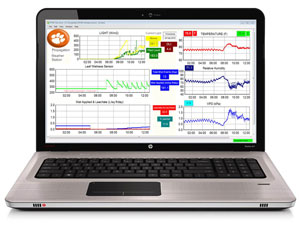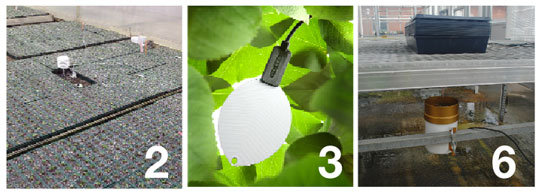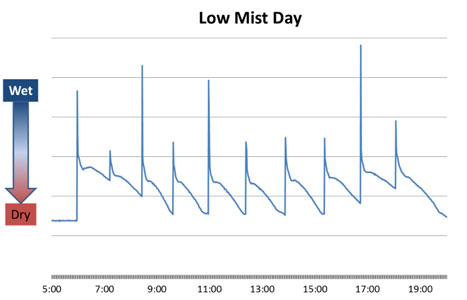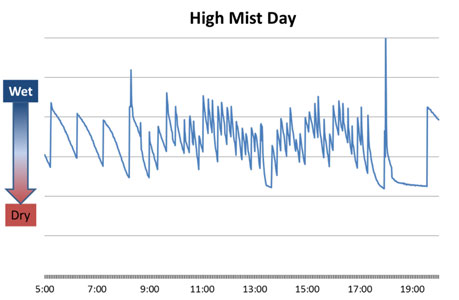11/26/2012
Monitor Your Propagation Anytime, Anywhere
Jeremy Crook

Our research project funded by the USDA-ARS Floriculture and Nursery Research Initiative focuses on improving water use efficiency in mist propagation systems. Managing water use to more precisely match the needs of the cuttings will have payoffs for growers in terms of reduced algal bloom, less nutrient and water waste, and minimal environmental impact.
Evaluating the amount of mist that one applies to cuttings in propagation can be challenging due to a constantly changing environment. It’s difficult, if not impossible, to walk into a greenhouse and know exactly how well watering is being managed. At one moment the cuttings can appear to be too wet, and a few hours later the cuttings can be wilting from being too dry. To address the challenge, we’ve developed a portable data logger and sensor network that we call the PropAgation Weather Station (PAWS).
What is PAWS?
The beauty of PAWS is that the data being collected is graphed in real time (Figure 1, above) and remotely accessible via the Internet for users to be able to view anywhere and anytime. This provides a tremendous tool for evaluating mist propagation systems and mist recipes over time without walking the greenhouse every half hour of the day and night.
PAWS is comprised of several components. A data logger collects electronic signals from several sensors placed on a propagation bench. These sensors are temperature, relative humidity and leaf wetness measured on the propagation bench, leachate measured under the bench, and light intensity measured at both the plant level and at the truss. Using these sensors, vapor pressure deficit (VPD), daily light integral (DLI) and the leaching percentage (defined as the percentage of water applied through the mist system that’s leached out of the bottom of propagation trays) are calculated and graphed onscreen.
The temperature, humidity and light sensors measured by PAWS are only different from the normal environmental measurements made by climate-control computers in that the measurements are made directly on the propagation bench (Figure 2). Thus, the sensors measure the microclimate experienced by the cuttings rather than the climate occurring several feet above the crop, where weather stations for climate-control systems are usually mounted.
Figure 2. PAWS installed on bench in a grower’s propagation greenhouse.
Figure 3. Leaf wetness sensors (Decagon Devices Inc.) mimic evaporation of water from leaf surfaces.
Figure 6. A tipping bucket rain gauge mounted under the bench is used to measure leachate dripping from a plug tray sitting in a standard 1020 tray.

What does PAWS do?
The leaf wetness sensor used in our system (Figure 3) changes electrical resistance when water droplets cross the electrical grid embedded in the artificial leaf. Figure 4 displays the type of data measured by the leaf wetness sensor. For example, each peak indicates a mist event (the artificial leaf has become wet), then the peak slowly returns back down to the base level indicative of a dry leaf. Ideally, a mist event occurs just as the leaf is starting to dry, but before the leaf is completely dry. The artificial leaf shows quite clearly when a mist event occurs too quickly—for example, when the leaf barely dries between mist events (Figure 5). Combining this information with the climate data, one can then more clearly see the greenhouse conditions under which one is misting too frequently or infrequently.
 Figure 4. Leaf wetness sensor reading on a low-mist frequency day. Each peak represents a mist event followed by a declining line, which represents the sensor drying off.
Figure 4. Leaf wetness sensor reading on a low-mist frequency day. Each peak represents a mist event followed by a declining line, which represents the sensor drying off.
Figure 5. Leaf wetness sensor reading on a high-mist frequency day. Each peak represents a mist event followed by a declining line, which represents the sensor drying off. Notice there is not much drying between mist events during the middle of the day.
Leaching is an incredibly interesting and useful measurement for evaluating water use efficiency in propagation. A tipping bucket rain gauge (Figure 6) mounted under the bench measures the amount of water dripping out of the bottom of a plug tray. The percentage of water dripping out of the bottom of the tray compared to the amount of water applied during misting is the leaching percentage. Excessive leachate wastes water and fertilizer. High leachate is also an indicator that the media moisture is staying too wet and this will increase the amount of algae growing on the media surface.
There are several factors that will have an effect on the amount of water evaporating from the media and leaf surfaces. The first is the level of water that’s already in the plugs. The second factor is the amount of mist applied, and the third is the greenhouse environment. We’ve found in previous research that a saturation level of 85% to 95% is optimal for rooting in several species. If there’s too much mist applied, these levels will increase and have a negative effect on rooting. Also, when the media is saturated, then any water applied by mist will displace water in the media causing leachate to immediately drop out of the bottom of the plug trays. If the environment is relatively dry (high VPD) then more of the water applied would evaporate causing less leaching.

As we continue our research, we’ll be gaining better insight to the dynamic ebb and flow of water in these propagation systems. One part of our research involves better understanding of the water requirements of URCs. For example, we’ve observed that mist requirements decline each day the cuttings spend time in propagation even before roots are formed on the cutting. As we learn more about cutting water use requirements, we’ll be able to know when mist is required and when it isn’t. We’ll then develop models that enhance our ability to propagate with optimal environments, and these models can drive mist systems to precisely deliver the proper amount of water during propagation.
The plan for PAWS in 2013 is to send the system to cooperating businesses for one month at a time to monitor the propagation environments in different commercial propagators throughout the year. This data will further advance our goals of improving our observations of commercial propagation environments so that improved methods and tools can be developed toward implementing more sustainable water use practices in the greenhouse industry.
GT
Jeremy Crook is a graduate student and Jim Faust is an associate professor at Clemson University in South Carolina.